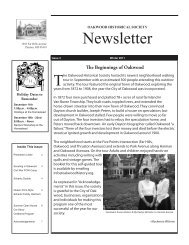Schantz Park Historic District Self-Guided Walking Tour - Oakwood ...
Schantz Park Historic District Self-Guided Walking Tour - Oakwood ...
Schantz Park Historic District Self-Guided Walking Tour - Oakwood ...
Create successful ePaper yourself
Turn your PDF publications into a flip-book with our unique Google optimized e-Paper software.
Queen Anne. The Queen Anne was the dominant style of residential<br />
architecture from 1880 to 1905 and is most associated with the Victorian<br />
period. This style features an irregular plan, bay windows, irregular<br />
roof shapes and differing wall textures, and often has a prominent turret<br />
accent. <strong>Oakwood</strong> and <strong>Schantz</strong> avenues have fine examples of Queen<br />
Anne homes.<br />
Shingle. Commonly built between 1880 and 1900, this style was not<br />
named until 1955 by architectural historian Vincent Scully. Unlike<br />
several styles from this period, the Shingle style is a distinctive American<br />
style, first used for New England summerhouses. Although it shares<br />
several traits with Queen Anne homes, the Shingle style differs through<br />
its predominant use of wood shingle wall treatments, sweeping rooflines,<br />
and overhanging eaves.<br />
Beaux Arts. This style literally means “Beautiful Arts” and was popular<br />
between 1885 and 1930. American architects who studied at France’s<br />
foremost architectural school, the Ecole des Beaux-Arts, introduced the<br />
style. With French and Greek Classical inspiration, it features elaborate<br />
detailing, a massive floor plan, and heavy masonry.<br />
Neoclassical. The World’s Columbian Exposition held in Chicago in<br />
1893 revived interest in classical models. The exposition’s planners<br />
mandated a classical theme, and many of the best-known architects of<br />
the day designed dramatic colonnaded buildings. The exposition was<br />
widely photographed, reported, and attended, and soon these Neoclassical<br />
models became the latest fashion throughout the country from 1895<br />
and remained popular until about 1950. The Adam <strong>Schantz</strong>, Sr. house<br />
at 430 <strong>Schantz</strong> Avenue is an example of an Italianate house transformed<br />
by the removal of its original full-width, one-story porch, and the<br />
placement of a two-story, full-width porch with Classical columns. The<br />
style features a symmetrical façade, full-height porch with columns, and<br />
classical ornamentation.<br />
International. Between World Wars I and II, Americans preferred<br />
revival style houses that reflected past traditions. In contrast, European<br />
architects emphasized radically new designs all working without historic<br />
precedents. Their work came to be known as International style. All<br />
superfluous ornamentation was stripped away, and clean lines prevailed.<br />
Common details include a flat roof without a ledge and a smooth<br />
unornamented wall surface, often stucco. A major modern architecture<br />
7




